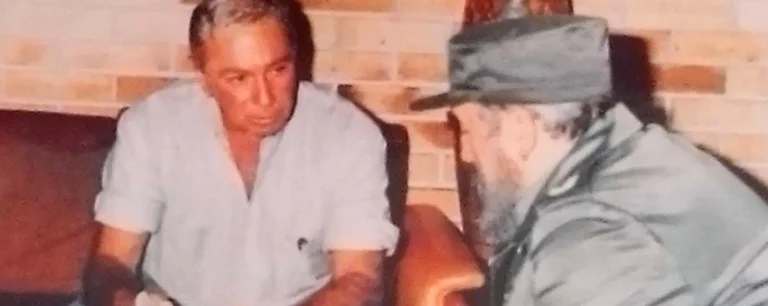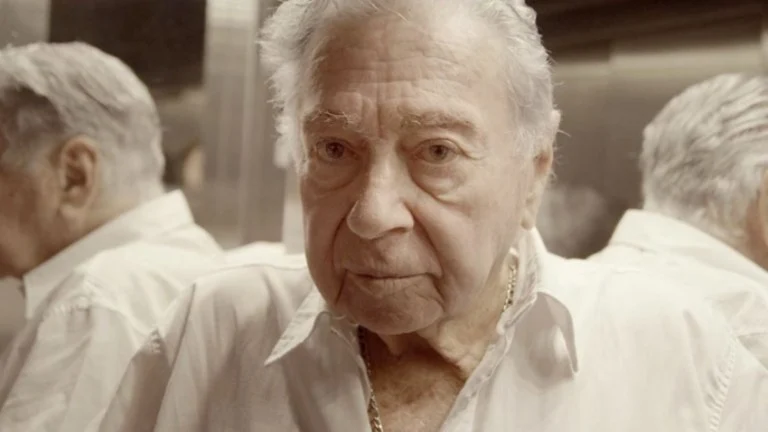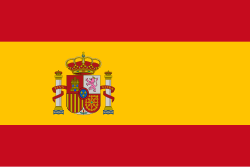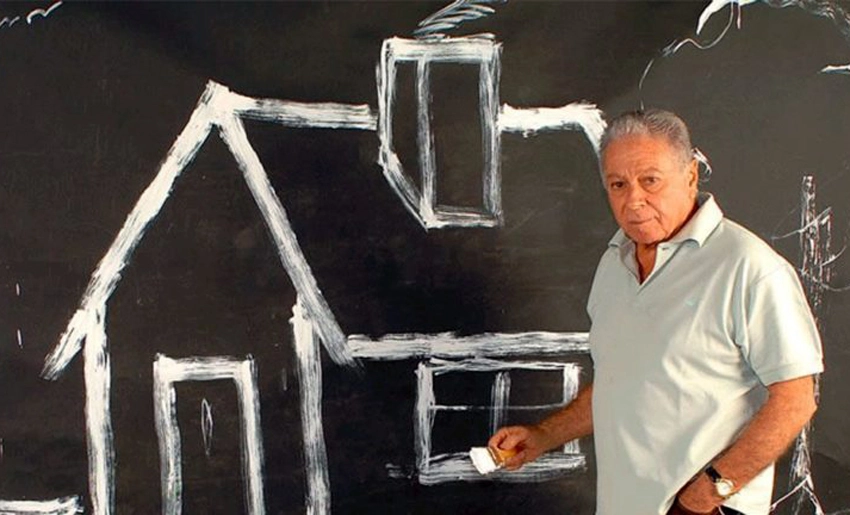Due to the sustained link of the late Argentine architect Rodolfo Livingston (August 22, 1931-January 6, 2023) with the nicknamed Largest of the Antilles for most of his 91 years, it is reasonable his expression: “My soul is Cuban”, he says in the book Cuba exists, is socialist and is not in coma, in which he recognizes how, in the midst of so many economic difficulties, “Cuba is not limited to its border. If Cuba did not exist, we would have to invent it”.
With good reason, those who knew him well in his country and in this land that welcomed him as a son, distinguish him as a very special human being, for his personal qualities and unquestionable professional merits; the way in which he devoted himself to the solidarity movement Chau Bloqueo and the admiration he felt for the leader of the Cuban revolution Fidel Castro, since he fought against the Batista tyranny and with whom he had an emotional meeting.
Rodolfo Livingston with Fidel Castro
Irene Rosa Perpiñal herself, founder -together with her husband Eladio González (Toto)- of the Ernesto Che Guevara Museum and the solidarity group Chau Bloqueo, remembers him as “a funny, rebellious, creative, generous and hard-working man; a person of action, who made his dreams come true without boasting about it. And his book -published in 1993- was the driving force behind thousands of Argentines who contacted us to support Cuba in those difficult times, due to the collapse of the socialist camp in Europe and the tightening of the U.S. blockade against the island”.
Livingston was among those who organized packages, as a member of the group -says Irene-: “a movement that, in a matter of seven years, sent to Cuba 760 tons of resources destined to public health, education, the media and other organizations, in addition to the sustained exchange of correspondence”.

Regarding the intense life of the Argentinean supporter, the distinguished artist and radio broadcaster from Holguín, Martín Arranz said that he came to Cuba for the first time in 1961, when the Literacy Campaign was being carried out throughout the country and shortly after the victory against the mercenary invasion of Playa Girón, to participate in a Latin American Congress of Architects, representing the Faculty of Chaco, where he studied and worked.
As he had decided to put himself at the service of the revolutionary process -which at that time was developing the Land Reform, free education, health and cultural services-, instead of staying in Havana, he worked for two years in the construction of a settlement in the rural town of Turey, Baracoa, together with the men who would live there with their families, for which they had to clear a mangrove swamp and build an embankment to access the site, where the first 49 houses adjoining the Mabujabo road were built. Later, another 62 houses were built for the inhabitants of some intricate areas of the municipality.
Although those were intense years, nothing stopped Livingston. He fulfilled his purpose and returned to Argentina, where he worked as a professor in three universities, without taking his eyes off what was happening in Cuba, where he returned in 1991, to participate in the Third International Conference on Architecture and Urbanism, then becoming supervisor of the program called Architects of the Community, which he had proposed, and in that effort he traveled almost the entire country, under the premise that, “in the conception and implementation of housing spaces it is essential the co-protagonism of those who will reside in them”.
In this way he visited Camagüey, Trinidad, Cienfuegos, Sancti Spíritus, Santiago de Cuba, Cayo Hueso in Havana and the cities of Holguín and Gibara, where he interacted with professionals from various sectors and, of course, Baracoa, where he received the grateful embrace of the workers who became builders and their families, about which event he confessed that there were many emotions. “I received 600 hugs in my neighborhood in Baracoa, among very tall trees, and it was the most intense experience I had in my life”.
During his frequent trips he gave seminars and lectures, however, such was his modesty that in an extensive interview granted to Chilean writer Martha Hanaecker he stated:
I did not bring to Cuba any new model of housing, nor plans, nor materials, nor fashions. My contribution was to have managed to bring together the clients with the architects and the architects with their own creativity. Everything was there.
On the talks he had with Cuban leader Fidel Castro, whose historical personality occupied a privileged place in his memory, he commented in his own interview with Chilean Martha Hanaecker:
Imagine, Fidel is Fidel: everybody talks about Fidel, and as it happens to everybody, I wanted to see Fidel dressed as Fidel, to see Fidel’s beard, Fidel’s hat, I thought I was in a movie, I couldn’t believe it; and I did it: I saw Fidel. We talked, I told him the whole plan of the architects of the community, he listened very attentively and almost without interrupting.
Livingston is the author of ten books, a columnist for the Juventud Rebelde newspaper for two years; an excellent speaker who clearly presented his renovating ideas and always supported the just Cuban cause, expressing his confidence that everything would pass as he commented to Martín Arranz, also a Buenos Aires music promoter: “Cuba is not alone, people like you are the ones who sustain this Cuba that does not fall”.
To Fidel Castro and Martín Arranz he gave copies of his book Cuba exists, is socialist and is not in coma. He also published Cuba rebelde. El sueño continúa, in which he addressed the renewed and convincing resistance of this people, blockaded and constantly harassed by the U.S. empire.
In his 91 years of life he never did anything for personal interest because, as he explained: “I was already rich when I was a boy. Being rich was not my life’s ambition”. This conviction brought him closer to Marti’s concept that: “Simplicity is greatness. To love is the way to grow”.
Rodolfo Livingston

Rightly so, Martín Arranz from Holguín, the Argentines Eladio González (Toto) and Irene Perpiñal, and many other people from both countries, who knew him well and shared his noble ideas and performances, prefer to remember him alive, facing new battles; and as the restless Toto commented, Livingston would be among those who continue raising banners against the blockade and for the withdrawal of Cuba from the spurious list of alleged countries that sponsor terrorism.
Irene, Toto and Arranz agree that the best and definitive cure for so many ills, such as those suffered by Palestine and other countries, including Argentina itself, was proposed by Che -a fellow countryman of the worthy couple and of Livingston, who considered him his friend-: “Only the death of capitalism will save humanity”.
- Love for Cuba, says Peruvian professor living in Canada - 10 de October de 2025
- Pioneers from Holguin raise their voices in favor of peace - 29 de September de 2025
- The Memory that Saves Project Grows and Strengthens - 26 de September de 2025

